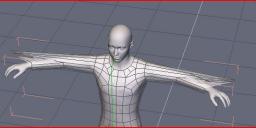Help - why does this keep happening?
 anikad
Posts: 1,919
anikad
Posts: 1,919
Almost everytime I select an edge in hexagon to try and delete polygons this keeps happening. How do I stop it happening and undo it, if it happens again? Clicking undo does not work. Currently I have to delete everything and start again, very annoying.


hex.JPG
624 x 275 - 33K
Post edited by anikad on


Comments
Depends how the mesh is made and/or welded. If you change the edge loop of lines to "points" [option under Selection], then delete, the desired faces should delete.
Saving and/or "incre-saving" saves time ;-)
Also welding dots and/or lines can repair some of the situations that develop when sections are deleted. It might also help to turn off symmetry.
There are two causes of this problem:
1) The first is that Hexagon's Symmetry algorithm is... borked. (Well, at least it used to be.) So, any strangeness going on when symmetry is active is, almost always, due to that.
2) However, that is not entirely the case, here. Your shirt object is sub-divided. You have not collapsed the subdivision on it and are deleting vertices with existing, active, sub-division. What that means is that the nice, orderly, algorithm that Hexagon used when it first calc'd your sub-D.... no longer applies. Hexagon is losing its mind, trying to figure out how in the heck those vertices disappeared from an active sub-d matrix. It is trying to compensate and it needs a good does of valium... :)
1 & 2 combined obviously makes the operation you're doing very unpredictable for Hexagon. :)
To fix it, don't delet verts/faces/edges when subdivision is still active and expect the subdivided shape to be retained - It won't be. Instead, if you have to remove something, either go back to the original sub-d level it was created in, remove it, then return back to the sub-d level you were working on or... just collapse the sub-d and delete/create as you wish.
It's generally best, and makes for more predictable modeling, to work on sub-D at certain levels, only moving up to a denser mesh when you are ready to create meaningful details at that density. It's a good idea to collapse your model, copy it, hide the original, then work on a sub-d'd mesh, doing what you need, then collapse it, copy it, hide the original, and work on a denser version. Yes, Hexagon has a sort of "memory" for each sub-d level, but it doesn't quite work like one might think it does. In short - It's all just maths and most 3D modeling is visual, so it's difficult to predict certain types of results.